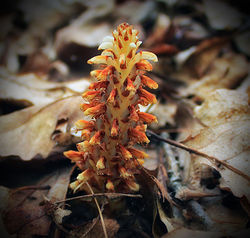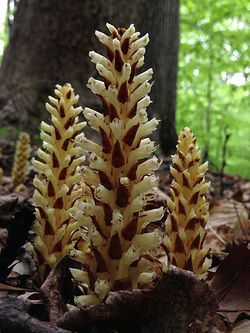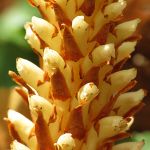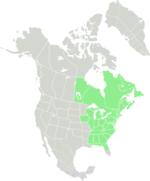American cancer-root
| American cancer-root |
|---|

|
| Scientific Classification |
|
| Scientific Name |
|
Conopholis americana |
The American cancer-root (also known as the squawroot or bear root) is a low growing, brown, scaly plant that grows up to heights of one foot tall at maturity. They are often found in dense clumps in oak and beech forests throughout eastern United states and eastern Canada. It is a non photosynthetic that relies on their host to survive. [2]
Body Design
The American cancer-root has a very interesting body structure. They grow about three to eight inches (7.62 - 20.32 cm). It is tall and has no branches. They are more like thick spikes of flowers. The leaves are reduced to scales. Around late-spring, the plant turns to more of a cream color and becomes hairless. Each leaf is about half an inch long.[3] When they bloom, they are a white and yellow-brown color. The fruit is only 8-12 millimeters and the fruit is dry and splits open when it is ripe. The edge blade of the leaf has teeth and are simple (undivided).[4]
Life Cycle
The American Cancer root is a perennial.[1] It's seedlings grow underground for roughly around four years. During those four years, the root of the plant attaches to the roots of its host tree forming a large, swollen knobs. At four years, the plant grows its scaly, flowering stem. The plant grows some yellow to cream-colored flowers alongside the stem. It has a scent that some people describe the scent as a scent between cabbage or carrion. Flies and bumble bees are its main pollinators.[2]
Ecology
The American cancer-root is a native plant to North America. The plant is native to Alabama, Connecticut, Delaware, Florida, Georgia, Illinois, Indiana, Kentucky, Maine, Maryland, Massachusetts, Michigan, New Hampshire, New Jersey, New York, North Carolina, Nova Scotia, Ohio, Pennsylvania, Rhode Island, South Carolina, Tennessee, Vermont, Virginia, West Virginia, Wisconsin. It can also be found in Canada in provinces such as Nova Scotia, Ontario, and Quebec. Also it has been reported to be in Costa Rica, Mexico, Panama, and Romania. [1]
The plant can be found in most of eastern North america. It grows on sites that have rich with deep soils and a thick forest canopy where at least some oak trees are present. It is usually found in dense clumps of several erect stems in a shady forest.[5]
Uses
The American cancer root is an edible plant that has a history for being used for medicinal purposes as an astringent for many years. The name if the plant came from Native Americans who used the plant as a remedy for menopause. In the current days, the plant has been used to treat things such as headaches, hemorrhages, and bleeding in of the bowel and uterus. [6] It can also be used to brew teas.[2]
Animals can also use the American cancer root. Both the seeds and the aging stalks are consumed by many mammals including the white-tailed deer and the black bear. The seeds can be found all over forests because of the animals. [2]
Video
References
- ↑ 1.0 1.1 1.2 Conopholis americana (L.) Wallr. American cancer-root USDA. Web. Accessed January 31, 2018
- ↑ 2.0 2.1 2.2 2.3 Squawroot The Virtual Nature Trail at Penn State New Kensington. Web. Last updated July 21, 2014. author unknown
- ↑ Cancer Root Illinois Wild Flowers. Accessed January 18, 2018. author unknown
- ↑ Conopholis americana Go Botany. Web. accessed January 18, 2018. Author Unknown
- ↑ Jaunzems, Mark American cancer-root (Conopholis americana (L.) Wallr.) USDA. Web. January 18, 2018
- ↑ Squawroot Plant Info: What Is Squawroot Flower Gardening Know How. Web. accessed February 1, 2018. Author Unknown



